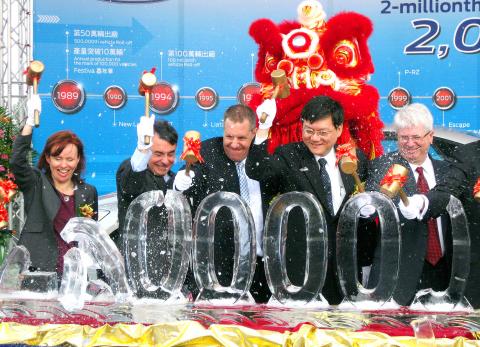Ford Motor Co, the second--biggest US automaker, is unfazed by growing competition from the Asia--Pacific and African (APA) automobile industry and is aiming to grow its business with a rollout of more models to customers in the region.
“Ford, for many years, has not brought all its products to the APA for different reasons. But our plans for the next several years are to bring a significant number of great products and develop new ones to add to the current product portfolio for the APA,” said Joe Hinrichs, president of Ford’s Asia-Pacific and Africa operations.
In Taiwan Ford will add four vehicle models within the next three years as part of its expansion plan in the region, he said.

Photo: CNA
Hinrichs refused to divulge the details, but said “most” of these models will be produced in Taiwan and are tailored for the consumers here.
“That [variety of offerings] gives us confidence and excitement when competing with all competitors in the APA, including Luxgen and Toyota,” he said.
Taiwan’s Yulon Motor Co (裕隆汽車) is set to introduce its own-brand vehicle Luxgen to China next year, after seeing great success on its home turf.
Luxgen boasts global positioning, night vision and blind-spot cameras — and at NT$800,000 (US$25,000), the company hopes it will appeal to tech-savvy and moderately wealthy Chinese consumers.
Hinrichs was in Taiwan for a one-night stopover to attend the 2 millionth vehicle rollout ceremony at Ford Lio Ho Co’s (福特六和) plant in Jhongli (中壢), Taoyuan County.
Set up in 1972, Ford Lio Ho is a joint venture between Ford and Lio Ho Group.
Ford predicts that over the next decade, 70 percent of the company’s business growth will be driven by the APA region, mainly China, India, South Africa and ASEAN, Hinrichs said.
The APA vehicle industry has a projected market of more than 30 million units this year, dominated by China, with 18 million, he said.
Ford lost US$86 million in the APA market last year, but it reversed the loss with earnings of US$166 million for the first three quarters on strong demand from China, where the second-largest contributor to GDP growth is the automotive sector.
“China is all about growth and the auto industry is growing very rapidly,” Hinrichs said.
The company said its vehicle sales in China for the first 10 months rose 40 percent from last year, and it is ushering in “record sales” for the year.
For Taiwan, the market is expected to improve next year, when as many as 330,000 cars are likely to be sold, Ford Lio Ho president Albert Li (李國寶) said.
“There is no sign of cooling down and my expectation is that the market next year will be steady at the minimum, but I see there could be some upside,” he said.

The US dollar was trading at NT$29.7 at 10am today on the Taipei Foreign Exchange, as the New Taiwan dollar gained NT$1.364 from the previous close last week. The NT dollar continued to rise today, after surging 3.07 percent on Friday. After opening at NT$30.91, the NT dollar gained more than NT$1 in just 15 minutes, briefly passing the NT$30 mark. Before the US Department of the Treasury's semi-annual currency report came out, expectations that the NT dollar would keep rising were already building. The NT dollar on Friday closed at NT$31.064, up by NT$0.953 — a 3.07 percent single-day gain. Today,

‘SHORT TERM’: The local currency would likely remain strong in the near term, driven by anticipated US trade pressure, capital inflows and expectations of a US Fed rate cut The US dollar is expected to fall below NT$30 in the near term, as traders anticipate increased pressure from Washington for Taiwan to allow the New Taiwan dollar to appreciate, Cathay United Bank (國泰世華銀行) chief economist Lin Chi-chao (林啟超) said. Following a sharp drop in the greenback against the NT dollar on Friday, Lin told the Central News Agency that the local currency is likely to remain strong in the short term, driven in part by market psychology surrounding anticipated US policy pressure. On Friday, the US dollar fell NT$0.953, or 3.07 percent, closing at NT$31.064 — its lowest level since Jan.

Hong Kong authorities ramped up sales of the local dollar as the greenback’s slide threatened the foreign-exchange peg. The Hong Kong Monetary Authority (HKMA) sold a record HK$60.5 billion (US$7.8 billion) of the city’s currency, according to an alert sent on its Bloomberg page yesterday in Asia, after it tested the upper end of its trading band. That added to the HK$56.1 billion of sales versus the greenback since Friday. The rapid intervention signals efforts from the city’s authorities to limit the local currency’s moves within its HK$7.75 to HK$7.85 per US dollar trading band. Heavy sales of the local dollar by

The Financial Supervisory Commission (FSC) yesterday met with some of the nation’s largest insurance companies as a skyrocketing New Taiwan dollar piles pressure on their hundreds of billions of dollars in US bond investments. The commission has asked some life insurance firms, among the biggest Asian holders of US debt, to discuss how the rapidly strengthening NT dollar has impacted their operations, people familiar with the matter said. The meeting took place as the NT dollar jumped as much as 5 percent yesterday, its biggest intraday gain in more than three decades. The local currency surged as exporters rushed to